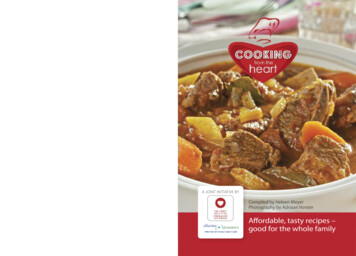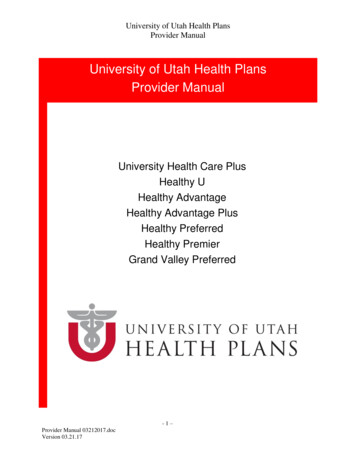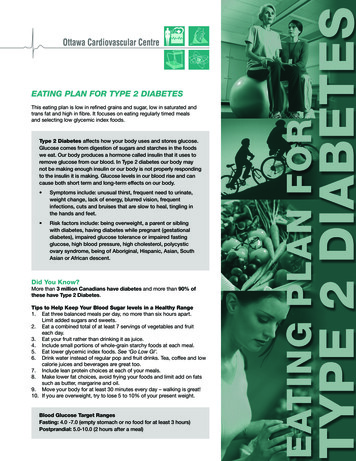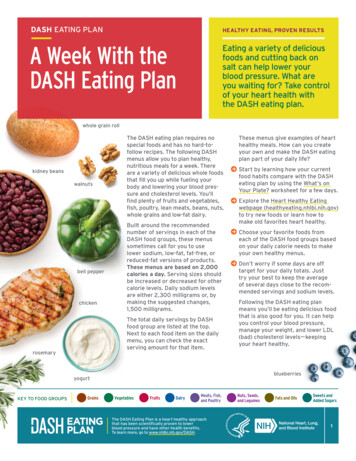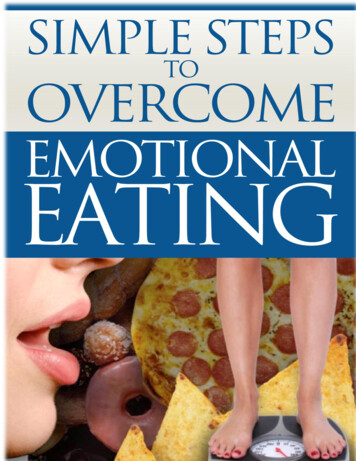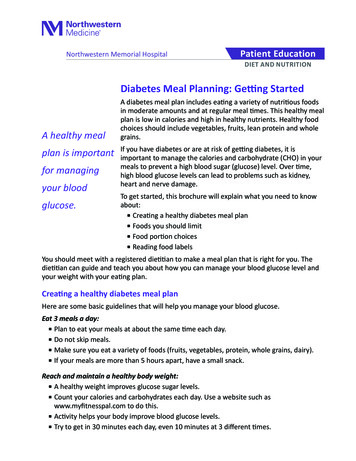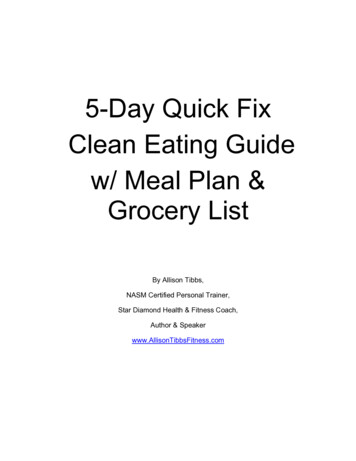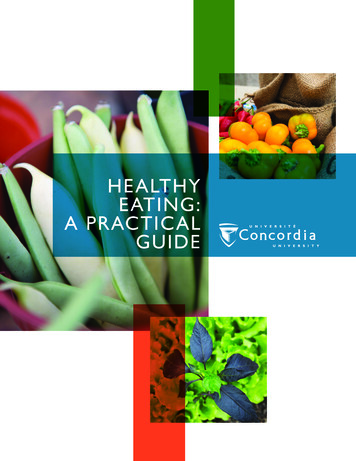
Transcription
HEALTHYEATING:A PRACTICALGUIDE
IN T RO2TABLE OF CONTENTSHEALTHY EATING: A PRACTICAL GUIDEYOURHEALTHIS YOURGREATESTRESOURCEThe healthier you are, the betterpoised you are to achieve goals in allareas of your life, including academic,career and personal goals.Eating nutritiously is one of the mostimportant things you can do to enhanceand maintain your health. This guide—madepossible through funding from the Ministèrede l’Éducation, du Loisir et du Sport,Québec—aims to provide you with practicaland reliable information that you can use tomake health-enhancing choices about thefoods and beverages you consume.If you take away only one message fromthis booklet, let it be this: A healthy diet is aplant-based diet! Read on for much moreinformation on healthy eating.Qualities of a healthy diet 3Benefits of a healthy diet 3General strategies to achieve a healthy diet 4Healthy diet guidelines 5How to use Canada’s Food Guide 7How to read a food label 1016 ways to get more plant foods into your diet 12Tips for eating well on a budget 14Vegetarian and vegan diets 15Healthy nutrition for athletes and active people 16Nutrition and healthy weight 18Alcohol 20Understanding nutrients 21How to set, achieve and maintain health goals 24Nutrition resources 24CONCORDIA UNIVERSITYHEALTH SERVICESSir George Williams Campus1550 de Maisonneuve W., GM 200514-848-2424 ext. 3565Loyola Campus7141 Sherbrooke St. W., AD 131514-848-2424 ext. 3575concordia.ca/health
QUALITIES OF AHEALTHY DIETThe principles of a healthy diet canbe summarized in a few key points.A healthy diet is: Generally low in fat, and specifically lowin “unhealthy” saturated and trans fat.A high-fat diet—or one that is rich in“unhealthy” fats—increases a person’s riskfor chronic health problems that includeheart disease, diabetes and stroke. Low in added sugars. Sugars occur naturallyin foods such as fruit and milk. Added sugars,such as those in non-diet soft drinks orcandies, contribute to obesity and they mayraise the risk of heart disease and diabetes. High in fiber. A high-fiber diet is linked withbetter health and a reduced risk of somechronic illnesses. Low in cholesterol. A diet rich in dietarycholesterol contributes to cardiovasculardisease. Rich in vitamins and minerals. Calorie balanced. Getting more energy (i.e.calories) than your body needs results inweight gain.The numerous benefits of a healthy dietinclude: a reduced risk of illness and disease,including cardiovascular illness (heartdisease and stroke), diabetes and somecancers a stronger immune system achievement and maintenance of ahealthy weight increased energy better sleep improved concentration/performance better sex better mood bowel regularity healthy skin, hair and teeth a greater sense of health and well-being and it’s much better for theenvironmentHEALTHY EATING: A PRACTICAL GUIDE Low in sodium. A diet high in sodium islinked to an increased risk for high bloodpressure and its associated health problems(e.g. heart disease).THE BENEFITS OFA HEALTHY DIET3
GENERAL STRATEGIESTO ACHIEVE AHEALTHY DIETEating healthfully is easierthan you think.Just as there are a few principles to a healthydiet, there are a few general approaches tohealthy eating. They include: Eat lots of plants. Plant foods tend to below in fat, calories and sodium; plus theyhave no cholesterol. They also have fiberand are often rich in vitamins, minerals andother beneficial compounds. Consume a variety of foods. This ensuresthat you get a full complement of nutrients.HEALTHY EATING: A PRACTICAL GUIDE Eat regularly throughout the day. Aim fora breakfast, lunch and dinner along with afew snacks.4 Eat foods as close to their natural stateas possible. The processing of foods stripsthem of valuable nutrients. Unhealthyingredients such as salt, sugar or fat areoften added to processed foods. Focus on healthy fats. The amount of fat inthe diet is not as important to your healthas the type of fat. Healthy “unsaturated”fats are found mainly in plant foods (e.g.olive oil, canola oil). When you chooseanimal foods—which are a main source ofunhealthy fat—opt for lower fat versions,such as lean cuts of meat or low-fat milk,yogurt and cheese. Beware of liquids. Liquids can add asignificant amount of additional caloriesto a diet, which can result in weight gain.Choose water often to satisfy your thirst.Nutrition advice is the most requested topicfor health education at Concordia HealthServices and the number one issue studentssay they would change to enhance their health.There is an outstanding amount of informationavailable on nutrition, but much of it ismisleading or inaccurate. This can be confusing.This booklet summarizes the most importantinformation you need to know about healthyeating and provides further resources shouldyou wish to learn more.If you want a step-by-step guide to changethe way you eat, consult the Health Servicesworkbook “How to Effectively Set, Achieveand Maintain Health Goals”. This is anevidence-based guide to making long-lastingchanges in any behaviour, including nutrition.On the back page of this booklet you can finda brief summary of the guide and informationon how to obtain a copy.REMEMBERThere is room for all kinds ofdelicious foods in a healthy diet. Icecream, potato chips and chocolatecan all be part of a healthy diet,as long as you eat these foodsoccasionally and in small amounts.
People get information about healthyeating from a variety of sourcesincluding the Internet, nutrition booksand even family and friends. Foodguides are an excellent way to learnabout healthy eating.Canada’s Food Guide is a tool that helps youmake food choices to improve your health andreduce your risk of illness. The Food Guide isupdated regularly to keep it consistent withthe latest science and to make sure it remainsunderstandable and useful. You can obtain theFood Guide at Health Services or downloada copy from the Health Canada ndex-eng.php).UNDERSTANDING CANADA’SFOOD GUIDECanada’s Food Guide providesrecommendations for the quantity and qualityof foods and beverages to consume foroptimal health. It places foods and beveragesinto four main groups: fruit and vegetables grain products milk and alternatives meat and alternativesC ANADA FO O D GU IDE S ERVINGREC O MMENDATIO NSFemale19–50Male19–50Female51 Male51 Fruits andVegetables7–88–1077Grain Products6–7867Milk andAlternatives2233Meat andAlternatives2323WHAT IS O NE FO O D GU IDE S ERVING ? Fruit and vegetables: ½ cup* frozen, fresh or cannedfruit or vegetables; 1 piece of fruit; 1 cup raw greens(e.g. lettuce, spinach). Grain products: 1 slice of bread (35 grams); ½ bagel,pita or tortilla; ½ cup cooked rice or other grains, orpasta; 30 grams of cold cereal; ¾ cup hot cereal. Milk and alternatives: 1 cup milk or soy milk, ¾ cupyogurt; 50 grams** cheese. Meat and alternatives: 75 grams (½ cup) cooked meat,poultry or shellfish; ¾ cup legumes (e.g. beans, lentils); 2eggs; 2 Tbsp peanut butter; ¼ cup nuts.* ½ cup 125 ml and is about the size of a tennis ball** 50 grams of cheese is about the size of two 9-volt batteriesHEALTHY EATING: A PRACTICAL GUIDEWithin each food group, the Food Guiderecommends a number of servings basedon age and sex. These are summarized inthe table to the right. The Food Guide alsoidentifies what one serving is. The panel on theright provides a general summary of servingsizes. You can find information on serving sizesfor a wide variety of foods from Canada’s FoodGuide website.Besides providing recommendations for thefour main food groups, the Food Guide alsoprovides recommendations for fats and oilsHEALTHYDIETGUIDELINES5
HEALTHY DIET GUIDELINES(30-45 mL, or 2-3 Tbsp per day) and it suggestslimiting foods that are high in calories, fat, sugaror salt (sodium) such as cakes and pastries,chocolate and candies, cookies and granola bars,doughnuts and muffins, ice cream and frozendesserts, French fries, potato chips, salty snacks,alcohol, fruit flavoured drinks, soft drinks, sportsand energy drinks, and sweetened hot or colddrinks. The Food Guide does not provide anumber of servings for these foods. The bestway to limit them is to set a daily calorie limit.Experts recommend that individuals aim toconsume not more than 150 calories a day fromthese foods.For each of the four main food groups, theFood Guide offers quality recommendations.These are:Fruit and vegetables Eat at least one dark green and one orangevegetable each day Choose vegetables and fruit prepared withlittle or no added fat, sugar or salt Have vegetables and fruit more oftenthan juiceHEALTHY EATING: A PRACTICAL GUIDEGrains Make at least half of your grain productswhole grain each day Choose grain products that are lower in fat,sugar or salt6Milk and alternatives Drink skim, 1%, or 2% milk each day orfortified soy beverage if you don’t drink milk Select lower fat milk alternativesMeat and alternatives Have meat alternatives such as beans, lentilsand tofu often Eat at least two Food Guide servings of fisheach week Select lean meat and alternatives preparedwith little or no added fat or salt.The quality recommendation for oils and fatsis to focus on the healthy “unsaturated” fats.These include olive oil, canola oil, and nonhydrogentated (soft) margarines. Also, butter,hard margarine, lard and shortening should belimited in a healthy diet.THE HARRIS - BENEDIC T E Q UATI O NFO R ES TIMATING YO U R DAI LYC ALO RIE NEEDSThe first step in estimating your daily calorie needsis to determine your Basal Metabolic Rate (BMR),which is the amount of calories you burn each daywhile at rest.IMPERIAL BMR FORMULAWomen: 655 (4.35 x weight in pounds) (4.7 x height in inches) - (4.7 x age in years)Men: 66 (6.23 x weight in pounds) (12.7 x height in inches) - (6.8 x age in years)METRIC BMR FORMULAWomen: 655 (9.6 x weight in kilos) (1.8 x height in cm) - (4.7 x age in years)Men: 66.5 (13.7 x weight in kilos) (5 x height in cm) - (6.8 x age in years)Once you know your BMR, you can multiply thatnumber by an activity multiplier* to estimate yourtotal daily calorie needs. Multiply your BMR by: 1.2 if you are sedentary (little or no exercise) 1.375 if you are lightly active (light exercise/sports 1-3 days/week) 1.55 if you are moderately active (moderateexercise/sports 3-5 days/week) 1.725 if you are very active (hard exercise/sports6-7 days a week) 1.9 if you are extra active (very hard exercise/sports & physical job or training 2 times a day)Estimate of my daily calorie needs: calories*These categories are quite broad. If you find that your activitylevel falls somewhere between two categories, determine an activitymultiplier between the two that you think would be most appropriate. For example, you walk most places so you wouldn’t consideryourself sedentary, but you believe the amount of walking you dowouldn’t put you in the lightly active category so you decide to use1.325 as your activity multiplier.
HOW TO USE CANADA’SFOOD GUIDEThe serving recommendations inthe Food Guide are based on thedaily energy needs of the averageCanadian male and female. fruit and vegetables: 9-10 servings(instead of 7-8)Maria is 22 years old, 5’6” (66”) tall, and weighs 145 pounds. Shegets together with friends for a friendly game of basketball twice aweek, each game lasting about an hour. She also goes for a 30 minjog twice a week. Based on these activities she determines that sheis moderately active. Her calculations for BMR are:BMR 655 (4.35 x 145) (4.7 x 66) – (4.7 x 22)BMR 655 630.75 310.2 – 103.4BMR 1492.55Daily calorie needs BMR x activity multiplier 1492.55 x 1.55 2313 calories per day grain products: 7.5-9 servings(instead of 6-7) milk/alternatives: 2.5 servings (instead of 2) meat/alternatives: 2.5 servings (instead of 2).She may also decide to increase her intake ofoils and fats to 3 – 4 tablespoons—rather thanthe 2 – 3 tablespoons that are recommended.Finally, she may also wish to includediscretionary calories (maybe 200 for thisactive female) for foods that are not found inthe four main food groups such as ice cream,chips or alcohol.If your energy needs are significantly lessthan the reference individual, you wouldproportionately decrease the number ofservings in each food group and factor in somediscretionary calories for foods not found inthe four main food groups.Now that you know how many servings toaim for, you can plan out your meals and snacksfor the day. Monitoring is extremely importantHEALTHY EATING: A PRACTICAL GUIDEFor the 19-50 year age group the averagefemale requires 1,850 calories while the averagemale requires 2,400 calories per day. You willneed to adjust the number of servings you needbased on your size, activity level and weightgoals. To do this, you first need to estimate yourdaily energy needs, which can be done using theHarris-Benedict equation (see page 6).If your estimated calorie needs are similarto those of the reference individual, you canuse the number of servings recommendedin the Food Guide. You could also include asmall amount of discretionary calories—150calories for example—so that you can includefoods and beverages that are not in the fourmain food groups such as cake, sweets, icecream or alcohol.If your calorie needs are significantlydifferent from those of the reference male orfemale, you will have to adjust the number ofservings to meet your energy and nutritionalneeds. If your energy needs are greaterthan the reference individual, you need toproportionately increase the amount of servingsin each food group. For example, a 20 year oldfemale athlete calculates that she burns about2,300 calories a day, which is approximately25% more than the reference individual. Shewould aim for 25% more of the recommendednumber of servings, which would be:ESTIMATING YOUR DAILY C ALORIE NEEDS:AN EXAMPLE7
TIPS FOR EFFECTIVE MONITORING Write things down: This is the most important aspect ofmonitoring. You may be tempted to think that you can monitor inyour head, but this doesn’t work. Having the information down onpaper helps guide changes, spot patterns and more. Be honest and accurate: There is no point in monitoring if you arenot going to be honest. You should also aim to be accurate in yourrecording. Don’t wait until the end of the day to record what you haveeaten. Record as soon as you can. Measuring will improve accuracy. Review your monitoring: Again, there is no point in monitoringif you are not going to use the information. At the end of eachday identify if you have reached your nutrition goal. The sooneryou identify that you are not on track, the sooner you can makechanges to get back on track. Develop a system that is easy to use: One of the greatest barrierspeople report about monitoring is that it takes time. To overcomethis, create a system that is easy to use. Besides the monitoringsheet presented here, there are many websites that offer programsto record food, exercise, weight and more. There are also mobileapps that you can use. More is better: Include as much detail as possible without makingmonitoring a terrible chore. The most important details fornutrition monitoring are the quantity and quality of food.As with any skill, it will take practice for youto get proficient at planning a day of healthyeating. You won’t need to record everythingyou eat for the rest of your life; rather, recordfor a while until you are confident in yourplanning. You may need to modify your plan asthings change in your life, such as a pregnancy,a change in physical activity, or a weight change.OTHER APPROACHES TOHEALTHY EATINGThe Canada Food Guide is practical, flexibleand based on good science; however, it is notthe only approach to healthy eating. Otherapproaches include other food guides (e.g.the Vegetarian Food Guide), guidelines fromother countries (e.g. Dietary Guidelines forAmericans), guidelines from organizations(e.g. The Nutrition Source from the HarvardSchool of Public Health), and some dietplans that are based on good science (e.g.Mediterranean Diet).8HOW TO USE CANADA’SFOOD GUIDEHEALTHY EATING: A PRACTICAL GUIDECOMPLETED MONITORING SHEETto ensure that you are on track with healthyeating, especially if you are trying to change yourdiet. An effective way of monitoring is to use aworksheet. It could look like an accounting sheetfor food. Divide the worksheet into columnsto record food category servings, oil servingsand discretionary calories; and rows to recordwhat you eat. Record both the quantity andthe quality of the food and indicate how manyservings the food represents in the appropriatecolumn. An example of a completed worksheetis shown to the right. On the following page ablank worksheet is presented that you can copy.You can use the worksheet to plan a day ofeating, or you can use it to monitor your eatingas the day progresses. Record the type andamount of food you have eaten as soon as youcan. Be honest. You may need to measure somefoods to be accurate.Date: September 20MY GOAL FOR THE DAYBreakfast1 whole grain bagel2 tbsp raspberry jam1 tbsp non-hydrogenated margarine1 banana1/2 cup unsweetened orange juiceMid-morning Snack1/4 cup almondsLunch1 cup pasta1 cup tomato/vegetable pasta sauceSalad of 1 cup lettuce 1/2 cupchopped vegetables1 tbsp low-fat salad dressingMid-afternoon Snack1 low-fat granola bar3/4 cup low-fat yogurtDinner75 grams grilled salmon1 cup rice1 cup roasted vegetables1 tbsp olive oil for roastingEvening Snack50 grams cheeseMY TOTAL FOR THE DAYF/V8Gr6Milk Meat22Oil3Cal1502501111222110011221861223150
WORKSHEET TO PLAN A DAY OF HEALTHY EATINGACCORDING TO THE CANADA FOOD GUIDEUse this worksheet to plan a day of healthy eating ahead of time or torecord your food and beverage consumption as you go through yourday. Begin by entering in the “MY GOAL FOR THE DAY” row yourgoal for the number of servings in each food group as well as your goalfor the amount of calories of “other” foods and drinks. Then, recordwhat you plan to eat/drink—or what you have eaten/drunk—in the leftcolumn. Include details on quantity and quality (e.g. 1 cup skim milk, 2slices whole grain bread, 75 grams lean ground beef ). Next, record thenumber of servings of the food or beverage in the appropriate column(e.g. for 1 cup cooked white rice you would put 2 in the grains columnsince 1/2 cup of cooked rice is 1 serving). For “other” foods and drinks(e.g. chocolate, alcohol) record as accurately as possible the number ofcalories you have consumed. When the worksheet is complete, add theservings (or calories) in each column and write that number in the “MYTOTAL FOR THE DAY” row. Finally, compare your total with your goalto identify if you achieved your nutrition goal for the day.Enter Number of ServingsDate:F/VGrMilkMeatEnter CaloriesOilOtherBreakfastMid-morning SnackLunchMid-afternoon SnackDinnerMY GOAL FOR THE DAYMY TOTAL FOR THE DAYWhat is One Serving?Each of the following represents one serving. For a more comprehensive list consult the “choosing foods” section of the Canada Food Guide website.Fruit and vegetables: ½ cup* frozen, fresh or canned fruit or vegetables; 1 piece of fruit; 1 cup raw greens (e.g. lettuce) or ½ cup cooked greens (e.g. spinach)Grain products: 1 slice of bread (35 g); ½ bagel, pita or tortilla; ½ cup cooked rice or other grains, or pasta; 30 grams of cold cereal; ¾ cup hot cereal.Milk and alternatives: 1 cup milk or soy milk; ¾ cup yogurt; 50 grams** cheese.Meat and alternatives: 75 grams (½ cup) cooked meat, poultry or shellfish; ¾ cup legumes (e.g. beans, lentils); 2 eggs; 2 Tbsp peanut butter; ¼ cup nuts***Fats and oils: 1 Tablespoon oil, butter, margarine, mayonnaise, salad dressing*½ cup (125 ml) is about the size of a tennis ball **50 grams of cheese is about the size of two, 9-volt batteries*** ¼ cup is about the amount of nuts that fits flat in the palm of your hand.HEALTHY EATING: A PRACTICAL GUIDEEvening Snack9
food product. A “Nutrition Facts” panel for anut bar is used as an example. Here’s what tolook for:HOW TOREAD AFOODLABELNature ValleySWEET AND SALTYChewy Nut BarsPeanut(made with 100% Whole Grains)Nutrition FactsPer 1 bar (35 g)Amount% Daily ValueCalories 170Fat 9 g14%Saturated Fat 2.5 g Trans Fat 0 g13%HEALTHY EATING: A PRACTICAL GUIDECholesterol 0 mgSodium 140 mgCarbohydrate 19 g10Fibre 2 gSugars 11 gProtein 2 gVitamin ACalcium0%2%Food labels are anindispensable tool forthose who wish to eathealthfully.6%6%6%They are required by lawin Canada on all packaged4%foods, with a few exceptions.Vitamin C 0%Iron2%There are three main kindsof information on a label: the“Nutrition Facts” panel, the ingredient list, andthe nutrition claim.HOW TO READ A “NUTRITIONFACTS” PANELThe “Nutrition Facts” panel lists the servingsize, amount of calories per serving, and theamount of 13 nutrients per serving. It can beused to compare two different brands of a1. What is the serving size? In the nut barthe serving size is 1 bar that weighs 35grams. When comparing two products,make sure the serving sizes are the same.If they are not, you will need to do somecalculations to compare the same amountof food.2. How many calories are in a serving?There can be a big difference betweenbrands. Be aware that a food may seem tobe low-calorie but the serving size on the“Nutrition Facts” panel may be very small.The nut bar has 170 calories.3. What percentage of calories comes fromfat? The amount of fat on a “NutritionFacts” panel is listed in grams. This can beuseful to identify foods that are low in fat.However, you also need to consider whatpercentage of the total calories comesfrom fat. To do this multiply the grams offat by 9 (there are 9 calories per gram offat), divide that number by the total caloriesand then multiply by 100. For the nut barexample the percent of calories from fat [(9X9)/170]x100 48%. Almost half of thenut bar’s calories come from fat.4. Do saturated and trans fat account fora high proportion of total fat? Less thanone-third of the total fat in a healthy dietshould come from saturated and trans fat.The lower the better. The nutrition labelfor the nut bar indicates that it contains notrans fat, while saturated fat accounts forjust less than one-third of the total fat (2.5grams saturated fat in 9 grams of total fat).5. How much fiber is in the product? Aimfor at least 20 grams of fiber each day; andmore is even better. This bar contains some
fiber (2 grams). High fiber foods contain4-6 grams of fiber per serving.6. How much sugar is in the product?One teaspoon of sugar weighs 4 grams.Therefore, the nut bar has just less than3 teaspoons of sugar (11 grams). Note,though, that almost one-third of the weightof the bar is sugar (11 of the 35 grams)!7. Is the food low in sodium? You should aimto consume less than 2,300 mg of sodiumeach day; preferably 1,500 mgs. The nutbar is relatively low in sodium (140 mgs).8. Is the food rich in vitamins and minerals?The “Nutrition Facts” panel indicates “%Daily Value” numbers for two vitamins (Aand C) and two minerals (calcium and iron)only. You can tell if a food is rich in theseparticular nutrients if their “% Daily Value”is high.9. Is the food high in cholesterol? It isrecommended that you consume less than300 mg of cholesterol per day.10.Don’t pay too much attention to the“% Daily Values”. These values are basedon a 2,000 calorie/day diet, which is theamount of calories needed by a moderatelyactive person of 68 kg (150 pounds).Larger people and those who are moreactive require more calories. If you needmore or less than 2,000 calories a day, thisinformation will not be appropriate for you.However, it can give you an idea of whichnutrients are abundant (large % daily valuenumber) and which are not (low number).WHAT TO LOOK FOR IN THEINGREDIENT LISTThe ingredient list contains all ingredients inthe food. They are listed from most to least byweight. The closer an ingredient is to the topof the list, the more of it the food contains.Avoid or limit foods with the followingingredients at or near the top of the list: Hydrogenated or partially hydrogenated oils,which are all high in saturated or trans fat. Sugar, fructose, glucose, dextrose, and highfructose corn syrup, which are all forms ofadded sugar. Stone ground, enriched, bleached, ormultigrain flour, which are processedgrains. Opt for whole grains such as “wholewheat”, “whole rye”, or “whole oats”.The first six ingredients in the nut bar are:roasted peanuts, corn syrup, sugar, whole grainrolled oats, glucose-fructose and palm kerneloil. The label states “made with 100% wholegrains” but the bar contains more sugar, cornsyrup and peanuts than whole grains.NUTRITION CLAIMSA nutrition claim is a legally regulatedstatement that is meant to help you spothealthy foods. A few examples are: Calorie-reduced: 50% fewer calories thanthe regular version. High source of dietary fiber: At least 4grams of fiber per serving. Very high source of dietary fiber: At least 6grams of fiber per serving.Don’t base your food choices on the nutritionclaim only as it can be misleading. A food thatis calorie-reduced can still be high in calories; itjust means that it is not as high as the regularversion. The “Nutrition Facts” panel providesmuch richer information.
16 WAYS TO GETMORE PLANT FOODSINTO YOUR DIETSince a healthy diet is a plant baseddiet, an excellent strategy to improveyour diet is to increase the amountof plant foods you consume.Here are a few ideas for getting more plantsinto your diet.1HEALTHY EATING: A PRACTICAL GUIDEStock your fridge and pantry with plantbased foods. If you have plant foods onhand you are more likely to eat them.Plant foods include fruit and vegetables (fresh,frozen, canned or juice); lentils and beans(canned or dried); nuts and seeds; grains suchas rice, oats, bulgur, barley, millet and quinoaand foods made of them such as breads, pastaand cereal; and soy products such as tofu andsoy milk.122Pack some sliced vegetables into yourlunch. Make a healthy veggie dip byadding some spices (onion, garlic, dill,Tabasco, etc.) to fat-free sour cream and putsome in a small container to bring with theveggies.3Always have fruit handy. Put a piece offruit into your lunch or your back pack.Keep a small bowl of fruit on your deskor in a visible place in the house, such as on acounter top.4Have a salad. Don’t be limited toleafy greens topped with tomato andcucumber. Experiment! Try fennel,endives or cabbage. Add beans (e.g. kidneybeans), legumes (e.g. chickpeas) or fruit (e.g.sliced apple) to your vegetable salad. Make ahealthy vinaigrette by mixing two parts olive oilwith one part vinegar. Put the vinegar in a jarthat has a tight lid and add your favorite spicessuch as garlic, oregano, rosemary, mustard,pepper, dill or minced onion. Add a little bitof oil and shake vigorously until the vinegaris suspended in the oil. Repeat until you haveintegrated all the oil. Pack the salad and thedressing in separate containers.56Add extra canned, fresh or frozenvegetables to pasta sauces or stews.You can also add whole or mashed beansto pasta and other sauces.Make a sandwich. Be creative. Choosea different type of bread such as rye,a pita, a bagel or a tortilla. Fill yoursandwich with hummus or mashed avocadoand some vegetables such as green pepper,tomato, or cucumber. Use strong mustardinstead of mayonnaise or butter.7Discover new ways to prepare fruit. Forexample, cover some chopped banana,pineapple or peaches with a mixture oflemon juice and a little bit of brown sugar ormaple syrup and broil in the oven until bubbly.
8Grill vegetables. Baste some firmvegetables (e.g. eggplant, peppers,mushrooms, zucchini or corn) with oliveoil and grill them on a BBQ. Alternatively,drizzle vegetables with olive oil and spices,tightly wrap in aluminum foil, and place on theBBQ (or in the oven) until the vegetables aretender.910Instead of a soft drink, choose anunsweetened fruit juice or low-sodiumvegetable juice.Whip up a healthy fruit smoothiein just a few minutes by blendinglow-fat milk, soy milk, or fat-freeyogurt along with your favorite fresh or frozenfruit, some fruit juice, a few tablespoons ofleftover cooked grains (e.g. oatmeal), and afew ice cubes.11Make a fruit salad by assembling abowl of cut-up fruit and top withfat-free yogurt, chopped nuts, raisinsand perhaps a touch of something sweet likemaple syrup.If making soup seems like too much work,take canned soup such as minestrone, chickennoodle or even a plain tomato soup and addsome extra vegetables such as canned corn,peas, beans or carrots. Throw in some spicesfor extra taste.13Make your own healthy pizza athome in minutes. For the base,use a slice of toasted whole grainbread, a whole grain pita, or a whole graintortilla. Top with a mixture of tomato sauce,a bit of olive oil and some spices such as basiland oregano. Add your favorite choppedvegetables, such as zucchini, mushrooms,peppers, tomato, or olives. Finish with a bit ofcheese and bake at 375 F for 10-15 minutesuntil the cheese melts and bubbles.14Make a stir-fry. Stir-fry recipesand sauces are easy to find onthe Internet.1215Have a vegetarian day or twoduring the week. Try a MeatlessMonday or a Tofu Tuesday. Or, makea decision that every day one of your servingsof meat/alternatives will come from a plantbased source such as nuts or beans.16Snack on nuts, seeds or dried fruit.However, beware that dried fruithas a lot of natural sugars, and nutshave a lot of healthy fat and calories, so don’toverdo it with these tasty snacks.HEALTHY EATING: A PRACTICAL GUIDEHave soup. Making your ownsoup is very easy and home-madesoups freeze well. A basic souprecipe begins by stir-frying some choppedonions, garlic, celery and carrots in olive oilin a large pot until they are soft (about 5minutes). Add a liquid such as low-sodiumchicken or vegetable broth. Next add fresh,canned or frozen vegetables such as tomatoes,cauliflower, zucchini, green beans, corn,spinac
including the Internet, nutrition books and even family and friends. Food guides are an excellent way to learn about healthy eating. Canada’s Food Guide is a tool that helps you make food choices to improve your health and reduce your risk of illness. The F


